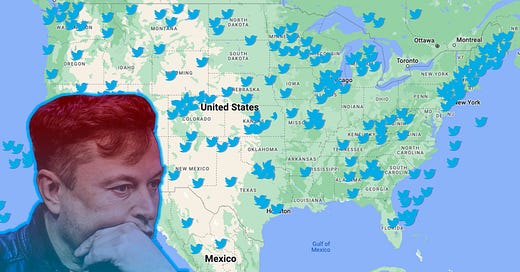
Twitter privacy rules change to explain the sudden ElonJet ban
Their owner’s account was also suspended; Musk vows legal action
➡️ The Shortcut Skinny: The old proxy doxy
❌ ElonJet tracker Jack Sweeney has all of his Twitter accounts suspended
👉 Twitter’s rules surrounding information sharing were changed Wednesday
📹 Musk shared video of person he says followed, harassed car containing his son
🛑 The video itself may violate Twitter’s doxxing rules
Twitter’s privacy rules have changed under new owner Elon Musk, and they help explain why ElonJet and all private jet Twitter tracker accounts have suddenly been suspended. But the reasoning is a little more complicated than anyone can explain in just 280 characters.
Jack Sweeney, the University of Central Florida student who owned ElonJet bot account that tracked the location and flight path of Elon Musk’s private plane, was banned early yesterday. Prior to the suspension’s widening, many media outlets, including The Shortcut, questioned the seeming tunnel vision of the original ElonJet Twitter ban after it was carried out without public explanation – the then-uneven application of the punishment came across as personal, considering Musk’s history with the account.
Late Wednesday afternoon, following an appeal by Sweeney, ElonJet was reportedly briefly reinstated, only to be taken down again. The New York Times, among others, said the student had told Twitter he would delay the posts so that they’re providing live updates of Musk’s private jet.
Musk tweeted later that accounts publishing real-time location info of anyone is a safety violation, but that doing so with a delay isn’t, and so is okay, echoing a rule that was added, in a flurry of changes, to its safety policies early Thursday morning, which Sweeney’s proposal would comply with. Nevertheless, Twitter removed not only his ElonJet account, but also his personal account and all of the over two dozen other plane-tracking accounts he administered. While information about the plane’s itinerary is technically public information, steps had been taken to dissociate it from the Twitter boss.
Keep up with the latest PS5 restock.
Musk’s safety concerns
Musk has maintained, at least since an early November tweet stating he wouldn’t remove the account, that information it published was a safety concern – a concern addressed by the FAA’s ADS-B Privacy page, where it lays out its Privacy ICAO aircraft address program that shields identifying information of flights meeting certain criteria.
To support his concern, he followed up his Wednesday tweet with one alleging that a driver, on Tuesday night, had followed and blocked a car containing Musk’s son, then climbed onto its hood in an attempt to get to the billionaire, who was not inside. In the same tweet, he stated that he would be taking legal action against Sweeney and “organizations who supported harm to [his] family.”
Three hours later, Musk tweeted a video that showed a clear, steady shot of both a driver of a car whose face was partially obscured by a mask and that car’s license plate. It didn’t fully capture the confrontation the events Musk had laid out.
Rules for thee, not for me
While not explicitly doxxing – license plates are, after all, very public information – Musk asked if anyone knows the driver, which could prompt another user to reveal identifying information about the person. One could see that as doxxing by proxy. The old proxy doxy, I like to call it.
To be clear, whatever the driver did in this instance was likely inexcusable. However, we have no way to know if Musk’s narrative is true or false, since we have only his words to go on, for now. It may well be this was a simple case of road rage, or perhaps the person was actually a fan trying to get in touch with the billionaire – we simply don’t know.
Though the general public can’t legally “run” a license plate, it wouldn’t be surprising for one of his 121 million followers to get and publish the driver’s identity – Musk, who could have asked local police to investigate, must be aware of the possibility. If the events didn’t go down as stated, he could find some legal trouble, as The First Amendment Coalition notes that sharing imagery of a person’s license plate constitutes an invasion of privacy “if the information is published in such a way so as to create a false and offensive impression about that person.”
The sharing of the video likewise appears to be in violation of Twitter’s own rules, which state both that it’s against the rules to share “media of private individuals without the permission of the person(s) depicted,” and that “sharing information that would enable individuals to hack or gain access to someone’s private information without their consent” is not permitted. In theory, sharing a license plate could enable a person to find information Twitter defines as private, such as the driver’s home address or “other identifying information related to locations that are considered private.”
A Twitter blog post announcing the addition of those rules acknowledged that the company may allow at least imagery of a private individual in the aftermath of a violent event – it doesn’t go into detail about what constitutes a violent event, however.
It wouldn’t be the first time Musk has shown conflicting stances when it comes to doxxing. In May 2022, a 2007 article tweeted by journalist Glen Greenwald contained the address of another journalist, Molly Jong-Fast, who had recently criticized Musk during an MSNBC interview. Archived snapshots show the article was updated the following day to remove the address, but not before Musk replied with laughing emojis and a Spongebob Squarepants GIF in apparent support of Greenwald’s tweet.







